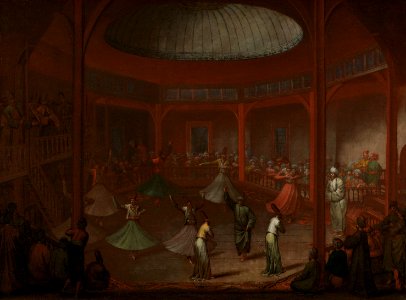Dervishes or islamic saints occupied a special place in religiously tolerant istanbul. Like christian monks, some dervishes roamed the countryside or cities, while others lived in communities or orders. The best-known order is that of the mevlevi dervishes, the followers of the philosopher and mystic poet jalal ad-din rumi (1207-1273), who is also called mevlana, 'our master'. Mevlevi dervishes try to contact allah through prayer, music and dazzling dance. During the dance, their right hand is raised to receive the heavenly blessing, which they transmit to earth with their left hand. Mevlana's followers lived in tekkes, also called mevlevihanesi. Vanmour painted the mevlevihane that stood near the palais de hollande in pera. It was the oldest in the city and consisted of a prayer hall or dance hall (semahane), rooms for the dervishes, a room and a special prayer room for their leader the sheikh, a women's section, a library, a dining room and kitchen, a public fountain, a bell chamber from which the hour of prayer was announced and a cemetery. The ceremony began when the leader of the dervishes left his seat and stood at the edge of the dance floor to address his followers. Vanmour has depicted him on the right of the painting in the contemplative pose that he would adopt during the entire ceremony. After this, the dervishes greeted their leader one by one, as the two men in the foreground do, and then began their prayer. By spinning in circles in the same place to the rhythm of the music, they fell into a trance. The dervishes wear the characteristic cylindrical hat, the goatee, and long woolen clothing that swirls around them in a beautiful circle as they spin. On the balcony, which we see at the top left, a flute is played. Vanmour has depicted two spectators very prominently. They stand behind the balustrade near the chair of the religious leader and their facial features closely resemble those of patrona halil and his accomplice muslu bese. It is unclear why vanmour depicted these key players from the 1730 revolt so prominently. It does help us date the painting, which must have been painted between october 1730 (just after the uprising) and november 1730 (the murder of patrona halil and his supporters). Collection: paintings; vanmour series. Object Type: painting. Date: between 1720 and 1737. Dimensions: height: 76 cm (29.9 in); width: 101 cm (39.7 in) geheel Gewicht: 7.2 kg (15.8 lb). Medium: oil on canvas. Collection: Rijksmuseum. Dansende derwisjen Rijksmuseum SK-A-4081
Loading...
